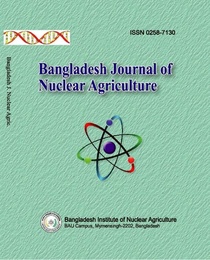MUTAGENIC EFFECT OF ETHYL METHANE SULFONATE ON SOME FIBER SPECIES
Abstract
Jute, kenaf and mesta are prominent fibrous plants with significant industrial and nutritional value for optimization of their cultivation process can have substantial agricultural and economic implications. The study was conducted on exploring the impact of ethyl methane sulfonate (EMS) presoaking treatments on the germination and the sensitivity of fiber crops to mutagens. This research aimed to evaluate the germination potential of jute, kenaf and mesta variety using various concentrations of EMS presoaking treatments, and analyze the sensitivity and induced variability in the M1 generation. Seeds were presoaked in four different concentrations of EMS. The subsequent parameters, including germination, root length, and shoot length, were measured at three crucial growth stages: 12, 24, and 36 days after sowing (DAS). A probit analysis was conducted to determine the LD50 value, which signifies the concentration at which 50% of the population exhibits an adverse effect. Moreover, significant variances were detected in germination rates, root elongation, and shoot growth across the different presoaking treatments. The findings emphasize the sensitivity of these fibrous plants to EMS concentrations, with increasing concentrations having a detrimental effect on growth parameters. This information can be instrumental for breeders and agriculturists looking to optimize germination in these crops.
References
Ahmed, Z. and Nizam, S.A. 2008. Jute - Microbiological and biochemical reserach. Plant Tissue Cult. & Biotechnol. 18: 197-220. BBS. 2015. Hand book of Agricultural Statistics, December, 2015. Bangladesh Bureau of Statistics (BBS).Ministry of Planning, Govt. People’s Repub. Bangladesh. Bolbhat, S.N. and Dhumal, K.N. 2009. Induced macromutations in horsegram [Macrotyloma uniflorum (Lam.) Verdc]. Legume Res. 32(4): 278–281. Finney, D.J. 1978. Statistical Method in Biological Assay. Charles Griffin Co. Islam, M.S., Saito, J.A., Emdad, E.M., Ahmed, B., Islam, M.M. 2017. Comparative genomics of two jute species and insight into fibre biogenesis. Nat. Plants. 3:16223. Manneh, B., Stam, P., Oliver, S. and Struic, P.C. 2007. QTL-base analysis of genotype by environmental interaction for grain yield of rice in stress and non- stress environment. Euphytica. 156: 213-226. Mei, S., Wu, Y., Zhang, Y., Liu, B.M., Jiang, J.Y., Xu, X. and Yu, Z.L. 2007. Mutation of rice (Oryza sativa L.) LOX-1/2 near-isogenic lines with ion beam implantation and study of their storability. Nuclear Instruments and Methods in Physics Research Section B: Beam Interaction and Materials and Atoms. 265: 495-500. Mir, R.R., Rustgi, S., Sharma, S., Singh, R., Goyal, A., Kumar, J., Tyagi, A.K., Khan, H., Sinha, M.K., Balyan, H.S. and Gupta, P.K. 2008. A preliminary genetic analysis of fibre traits and the use of new genomic SSRs for genetic diversity in jute. Euphytica. 161: 413-427. Mohamad, O., Nazir, M., Alias, B., Azlan, I., Rahim, S.A., Abdullah, H., Othman, M.Z., Hadzim, O., Saad, K., Habibuddin, H.A. and Golam, F. 2006. Development of improved rice varieties through the use of induced mutations in Malaysia. Plant Mutation Reports. 1: 27-34. Oladosu, Y., Rafi, M.Y., Abdullah, N., Hussin, G. and Ramli, A. 2016. Principle and application of plant mutagenesis in crop improvement: a review. Biotechnol. Biotech. Eq. 30:1–16. Rajarajan, D., Saraswathi, R. and Sassikumar, D. 2016. Determination of lethal dose and effect of gamma ray on germination percentage and seedling parameters in ADT (R) 47 rice. Int. J. Adv. Biotechnol. Res. 6(2): 328-332. Ramchander, S., Ushakumari, R. and Arumugam P.M. 2015. Lethal dose fixation and sensitivity of rice varieties to gamma radiation. Indian J. Agric. Res. 49 (1): 24-31. Sarker, R.H., Amin, A., Hossain, G. and Hoque, M. 2007. In vitro regeneration in three varieties of white jute (Corchorus capsularis L). Plant Tissue Cult. Biotechnol. 17:11–18. Scott, S., Jones, R. and Williams, W. 1984. Review of data analysis methods for seed germination. Crop Sci. 24: 1192–1199.
-
Download



